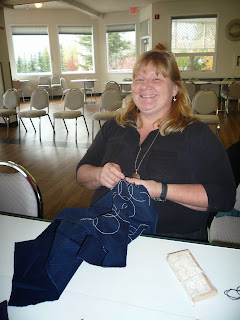(Rhonda, our instructor)
At last year's National Seminar of the Embroiderers' Association of Canada (EAC) I was impressed by how happy the students from one class were - those taking Barbara Gilbert's Sashiko class. While the rest of us were looking a bit frazzled at times, these ladies appeared so happy, stress-free and pleased with themselves. This was enough to make me want to learn more about this elegant Japanese stitching technique. So when my local guild, Calgary Guild of Needle & Fibre Arts (CGNFA), recently held a one day workshop on Sashiko and Kogin techniques, I could't resist!
(traditional sashiko pattern)
Sashiko, which translates literally into "little stabs", is a form of functional embroidery from Japan. It was traditionally used to reinforce garments and provide extra warmth. Now this running stitch technique is used for purely decorative purposes and the white cotton thread worked on indigo dyed fabric creates pieces with a simple elegance. The stitches are an even size which are said to resemble grains of rice. We spent the morning of the workshop working on a piece of sashiko.
(our workshop design)
(Rhonda working on a Kogin design)
I have been a member of CGNFA for over 25 years and I still love the opportunities it provides for learning and exploring new stitching techniques. As guild members, we are so fortunate to be able to do this. Sometimes it turns out to be something you will not do again. Sometimes it is a technique you end up embracing. The important thing is that we continue to learn and grow in our art and get inspiration from new techniques and viewpoints.
You can find many sites online for information on Sashiko and Kogin. Here are a few to get you started.
Links for more information on sashiko:
- Sashiko Stitching (Wikipedia)
- Japanese Sashiko Tutorial & Stitching Basics (uTube)
- Sashiko Stitchers
- Studio Aika
Links for more information on kogin:




Comments